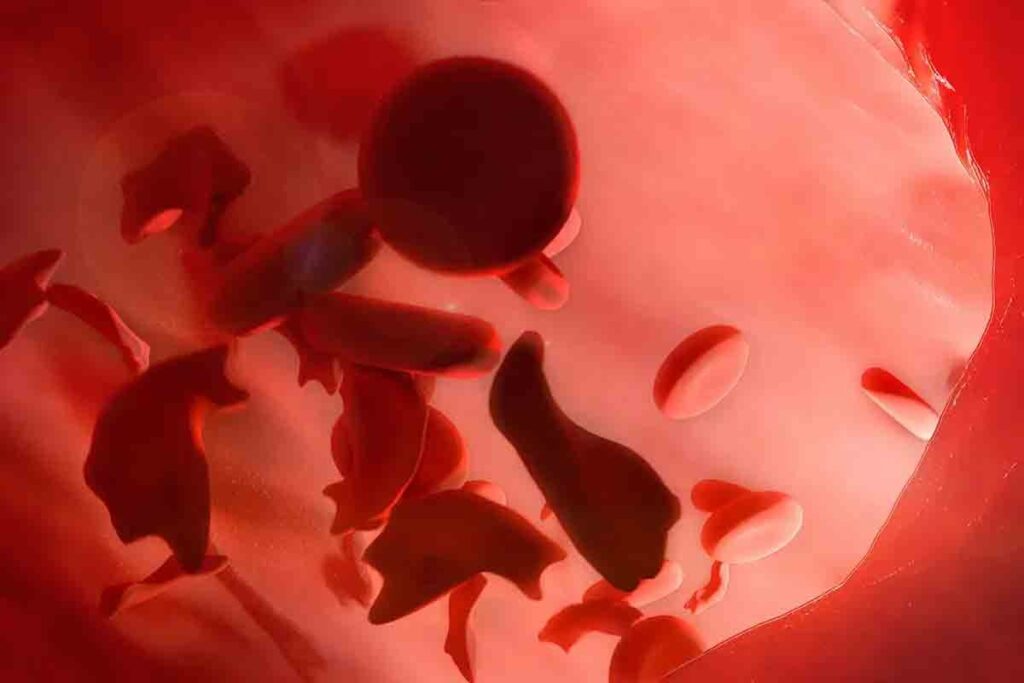
Sickle cell disease makes red blood cells bend in a sickle shape. This shape can block blood vessels. It stops blood from flowing well, causing tissue damage and severe pain. This pain, called a crisis pain, is a big worry for those with the disease.
At Liv Hospital, our teams are dedicated to helping with this pain. We aim to make life better for those with this tough condition. We know how hard it is to manage sickle cell disease, thanks to research at many hospitals.
We want to teach you about this condition. We also want to show we care, showing our professional yet warm side.

It’s important to understand sickle cell disease to see its effects on patients. This disease is a genetic disorder that affects how red blood cells make hemoglobin. We will look at what the disease is and its genetic roots.
Sickle cell disease is caused by abnormal hemoglobin, called hemoglobin S. This abnormal hemoglobin makes red blood cells bend into a sickle shape under certain conditions. This leads to health problems like pain, anemia, and a higher risk of infections.
The symptoms of sickle cell disease can differ a lot between people. Some may have mild symptoms, while others face severe and frequent pain and other issues.
Sickle cell disease is passed down in an autosomal recessive pattern. This means a person needs two defective hemoglobin genes, one from each parent, to have the disease. The disease is caused by a mutation in the HBB gene, which codes for a part of hemoglobin.
Carriers of the disease have one normal and one defective gene. They usually don’t show the full symptoms but can pass the defective gene to their kids. Knowing the genetic basis is key for genetic counseling and predicting disease inheritance.
| Genotype | Phenotype | Risk of Passing to Offspring |
| Normal (AA) | No disease | 0% |
| Carrier (AS) | Carrier, generally no disease | 50% |
| Sickle Cell Disease (SS) | Sickle Cell Disease | 100% |
Studies, like those by the University of Mississippi Medical Center (UMMC), shed light on sickle cell disease. They help us understand how to manage the disease better. Knowing the genetic basis is essential for creating targeted treatments and improving care for patients.

To understand why sickle cell disease causes pain, we need to look at its biological roots. This disease is a genetic disorder that affects how red blood cells make hemoglobin. This leads to the cells sickling under certain conditions.
Red blood cells sickle when abnormal hemoglobin (HbS) polymerizes in low oxygen. These sickled cells are less flexible and more likely to break down. They can also get stuck in small blood vessels, causing vascular occlusion.
Vascular occlusion is a key part of sickle cell disease. When sickled red blood cells block blood vessels, they stop normal blood flow to tissues and organs. This blockage can lead to pain and other problems.
The blockage of blood vessels by sickled red blood cells leads to tissue ischemia. This is when tissues don’t get enough blood flow, oxygen, or nutrients. Tissue ischemia also triggers inflammation, making things worse.
The inflammation response involves immune cells and pro-inflammatory cytokines. These cytokines help sickled red blood cells stick to the endothelium, continuing the cycle of blockage and damage.
The mix of tissue ischemia and inflammation is key to understanding why sickle cell disease causes pain. The pain comes from the body’s reaction to the damage from sickled red blood cells.
Important factors in sickle cell pain include:
Grasping these biological mechanisms is vital for finding effective ways to manage sickle cell pain.
For those with sickle cell disease, vaso-occlusive crises are a big pain. These episodes happen when sickled red blood cells block blood vessels. This causes tissue ischemia and pain.
A vaso-occlusive crisis, or pain crisis, happens when sickled red blood cells block blood flow. This leads to ischemia and pain in different parts of the body. It can affect bones, joints, and organs.
A vaso-occlusive crisis starts a chain of events that makes pain worse. First, sickled red blood cells stick to blood vessel walls. This causes inflammation and blocks blood flow even more.
As the crisis goes on, tissues don’t get enough oxygen. This leads to ischemia and pain signals to the brain. The pain can be very bad and affect both body and mind.
The pain from a vaso-occlusive crisis can vary a lot. Some people might have mild pain for a few hours. Others might have very bad pain that lasts for days.
The pain is often described as very painful. It can also come with fever, swelling, and tenderness. Knowing about vaso-occlusive crises helps find better ways to manage them. Studies show that a mix of treatments can really help people with sickle cell disease live better.
It’s important to know the different kinds of pain sickle cell disease can cause. This knowledge helps in managing and treating the pain. Patients with this condition face various types of pain that can really affect their life quality.
Acute pain episodes, or vaso-occlusive crises, are common in sickle cell disease. These happen when sickled red blood cells block blood vessels. This leads to tissue ischemia and pain. The pain is often sharp or stabbing and can be very severe.
Characteristics of Acute Pain Episodes:
Many patients with sickle cell disease also face chronic pain. This pain is ongoing or keeps coming back. It can be due to inflammation, organ damage, or other disease complications.
Chronic pain management needs a team effort. This includes medicines, physical therapy, and support for the mind.
| Characteristics | Acute Pain Episodes | Chronic Pain Patterns |
| Onset | Sudden | Gradual or persistent |
| Duration | Hours to days | Ongoing or recurrent over months |
| Triggers | Dehydration, infection, cold | Ongoing inflammation, organ damage |
| Management | Immediate medical attention | Multidisciplinary approach |
Some people with sickle cell disease also have neuropathic pain. This pain comes from nerve damage or problems. It can feel like burning, tingling, or shooting pain and is hard to manage.
There’s ongoing research to find better ways to manage pain in sickle cell disease. It’s key to understand the different types of pain. This helps in creating treatment plans that work best for each patient.
Neurological mechanisms are key in sickle cell pain, involving both central and peripheral parts. Sickle cell pain isn’t just from sickled red blood cells. It’s also how our nervous system handles and reacts to pain.
Central sensitization means our central nervous system becomes more sensitive to pain. In sickle cell disease, this makes pain feel worse. It’s because of changes in the brain and spinal cord from long-term pain.
Research shows sickle cell patients have different brain pain processing. This leads to more pain sensitivity. Even small things can hurt more.
Peripheral sensitization makes nerve endings more sensitive to pain. In sickle cell, this happens because of inflammation and tissue damage. These issues come from vaso-occlusive crises.
Together, central and peripheral sensitization make sickle cell pain complex. Knowing these mechanisms helps create better treatments. These treatments aim at the root causes of pain, not just the symptoms.
By tackling both central and peripheral sensitization, doctors can make treatment plans better. This improves life quality for those with sickle cell disease.
Triggers and risk factors are key in sickle cell pain crises. Knowing them helps patients and caregivers manage the condition better.
Environmental factors can trigger sickle cell pain crises. Extreme temperatures, hot or cold, can cause a crisis. Patients should avoid sudden temperature changes and dress for the weather.
High altitudes with low oxygen levels can also trigger crises. Patients should know these risks when traveling.
Physical exertion and emotional stress can start a sickle cell pain crisis. Patients should balance activity and rest to avoid too much strain.
Stress management techniques, like meditation and deep breathing, can help with emotional stress.
Dehydration is a big risk for sickle cell pain crises. Losing too much fluid increases red blood cell concentration, leading to sickling.
Patients should drink lots of water, more in hot weather or when sick with fever, vomiting, or diarrhea.
Infections can cause inflammation, leading to sickle cell pain crises. Patients should get medical help if they think they have an infection.
Preventive steps like vaccinations and antibiotics can lower infection risk.
By understanding and managing these triggers and risk factors, patients with sickle cell disease can lessen pain crises. This improves their quality of life.
Sickle cell disease can lead to serious complications that affect a patient’s life quality. These issues come from the disease’s impact on the body. This includes the sickling of red blood cells, blockages in blood vessels, and lack of blood flow to tissues.
Acute chest syndrome is a severe complication of sickle cell disease. It’s marked by a new lung issue on chest X-rays, fever, breathing problems, or chest pain. This condition can be caused by infection, fat in the blood, or lung damage. It needs quick medical care.
Stroke is a big risk for kids with sickle cell disease. The disease can block blood flow in the brain, causing stroke. Other brain problems, like silent strokes, can also happen. These may not show symptoms but can harm thinking skills.
Sickle cell disease can harm many organs due to blocked blood flow and lack of oxygen. Organ damage can affect the kidneys, liver, and heart, among others. Regular check-ups are key to catch and treat these problems early.
Not every health issue in sickle cell patients is caused by the disease. For example, high blood pressure or diabetes might happen alongside sickle cell but aren’t direct results of it. Knowing the difference is important for proper care.
Research on sickle cell disease complications helps doctors manage them better. By understanding these issues and their causes, healthcare teams can create better treatment plans. This improves how well patients do in the long run.
Managing sickle cell pain is a complex task. It requires both medicines and non-medical methods. These efforts are key to improving life for those with this condition.
Medicines are a mainstay in treating sickle cell pain. They include:
Studies show mixing these medicines can help manage sickle cell pain. For example, a study in a medical journal found a multi-modal approach works well.
| Pharmacological Approach | Description | Benefits |
| Opioids | Used for severe pain | Effective for acute pain crises |
| Non-opioid analgesics | Used for mild to moderate pain | Less risk of dependency |
| Adjuvant therapies | Used to manage side effects or enhance pain relief | Improves overall pain management |
Non-medical methods also help manage sickle cell pain. They include:
These methods can be used with medicines to better manage pain. For instance, relaxation techniques can help manage stress, which can cause pain crises.
Preventive steps are key to reducing pain crises. They include:
By using these strategies, people with sickle cell disease can lower their risk of pain crises.
New treatments are being developed to manage sickle cell pain. These include:
These new treatments are being researched to offer better options for managing sickle cell pain and improving patient outcomes.
Living with sickle cell disease means managing pain and other issues well. It’s key to improve life quality for those with this condition.
We’ve talked about why sickle cell pain happens, the types of pain, and how to manage it. Knowing what causes pain crises helps people avoid them.
Our institution offers top-notch healthcare and support for international patients. We focus on personalized care for those with sickle cell disease. Our goal is to help them manage their pain better.
By using a complete care plan, we can make treatment better and improve well-being. As we learn more about sickle cell disease, we’re committed to giving the best care and support to those with sickle cell pain.
Pain from a sickle cell crisis comes from sickled red blood cells blocking blood vessels. This causes tissue ischemia and inflammation.
Yes, sickle cell disease causes recurring pain. This is due to vaso-occlusive crises, chronic pain, and sometimes neuropathic pain.
Pain in sickle cell disease happens because of sickled red blood cells. They block blood vessels, causing tissue ischemia and inflammation.
A pain crisis, or vaso-occlusive crisis, is when sickled red blood cells block blood vessels. This causes severe pain that can last and vary in intensity.
Some conditions, like certain mental health disorders, are not complications of sickle cell disease. They don’t come from vaso-occlusion or chronic anemia.
Yes, sickle cell disease causes pain. This is through vaso-occlusive crises and chronic tissue damage.
Triggers for sickle cell pain crises include cold weather, stress, dehydration, and infections. These can start vaso-occlusive events.
Managing sickle cell pain involves medicine, hydration, rest, and avoiding triggers. This helps manage pain.
Patients with sickle cell disease face acute pain episodes, chronic pain, and sometimes neuropathic pain. They need a full management plan.
Yes, sickle cell anemia is painful. It has episodes of pain due to vaso-occlusive crises and other complications.
Sickle cell disease is painful because of sickled red blood cells. They block blood vessels, causing tissue ischemia and inflammation.
Pain in sickle cell disease comes from sickled red blood cells. They block blood vessels, causing ischemia and inflammation, and other complications.
Subscribe to our e-newsletter to stay informed about the latest innovations in the world of health and exclusive offers!
WhatsApp us